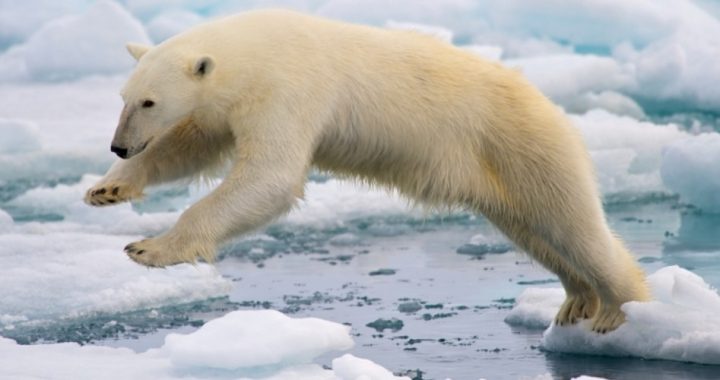
For many years, climate alarmists have been using photos of polar bears supposedly “stranded” on ice floes as evidence that the species is in mortal danger due to human-caused global warming. However, recent data points to the conclusion that polar bears may not be as endangered as the climate-alarmist community wants us to believe.
Sea ice is very important to polar bear populations, as the majority of their seal hunting occurs at sea from April to July. This is when the bears put on most of their yearly fat reserves, which allow them to survive the so-called food-free season, when opportunities for obtaining food lessen due to decreased sea ice. The narrative goes that when sea ice reaches the critical threshold of less than 50 percent concentration, the hunting season — and therefore the eating season — for polar bears comes to an end until the sea ice reconstitutes in three to four months.
But this year, five of eleven tagged female bears were still out on the ice as of August 7, far past when sea ice on Hudson Bay fell below the 50-percent concentration mark.
“And if five collared bears are out there, then there are almost certainly many more without collars doing the same thing,” writes zoologist Susan Crockford, who has long studied polar bears. Furthermore, Crockford maintains that the behavior has been going on for some time.
“This pattern of bears staying out on the ice long after the ‘critical threshold’ of 50 percent concentration has passed has been going on since at least 2015 and many bears on tracking maps in July and August appear to be on ice that doesn’t exist.”
We all know that polar bears are excellent swimmers, but they aren’t capable of surviving at sea without adequate sea ice. So, how are these bears bucking the trend?
According to Crockford, “There are two explanations for this pattern and both are likely true: 1) much more ice exists on Hudson Bay than satellites can detect and 2) polar bear experts are wrong that Western Hudson Bay polar bears head to land soon after sea ice concentration drops below 50 percent.”
The polar bear extinction alarmists insist that ice coverage below 50 percent in the summer greatly reduces survival rates for polar bears and portends a grim future for the species. But if a large number of bears are staying at sea despite reported lower ice levels, that’s good news, right?
But that good news is only short term according to Andrew Derocher, another polar bear researcher. Climate change, Derocher claims, is still a bogeyman coming for the polar bears. “Most W Hudson Bay polar bears are ashore but 5 are hanging on to the last ice. It’s unusual that bears are on so little ice but they’re close to shore and within swimming distance to land. A good ice year in 2020 in the Bay. The long term trend from climate change is the concern.”
However, Crockford points out that 2020 is not an anomaly when it comes to polar bears bucking the 50 percent sea ice concentration threshold. Since 2015, bears on Western Hudson Bay have stayed out on summer ice when it was well below the 50-percent mark. And the behavior isn’t limited to the Western Hudson Bay bears, as the bear population on the Southern Beaufort Sea north of Alaska has exhibited similar behavior.
Crockford is definitely a maverick when it comes to the study of polar bears. Last year, the scientist lost her position as an adjunct professor in the Anthropology Department at the University of Victoria in British Columbia. According to Crockford, she was let go because her research into polar bears and her conclusion that the bears might not be as endangered as climate alarmists are leading us to believe was the nail in her coffin.
Crockford was also a key figure in Facebook’s decision to censor PragerU. In May, the conservative non-profit featured Crockford in a video that ran counter to the climate-alarmist narrative that polar bears are being killed off due to climate change. Facebook, relying on the word of climate alarmist website Climate Feedback, limited the distribution of that video.
Crockford’s assertion that low Arctic sea ice might not be the death sentence for polar bears that climate alarmists claim is troublesome for the sky-is-falling-crowd. Polar bears have become one of climate alarmism’s mascots; if the species is not actually endangered, then maybe climate change isn’t the fearful monster that we’ve been told it is.
Image: Arturo de Frias Marques/Wikimedia Commons
James Murphy is a freelance journalist who writes on a variety of subjects. He can be reached at [email protected].



